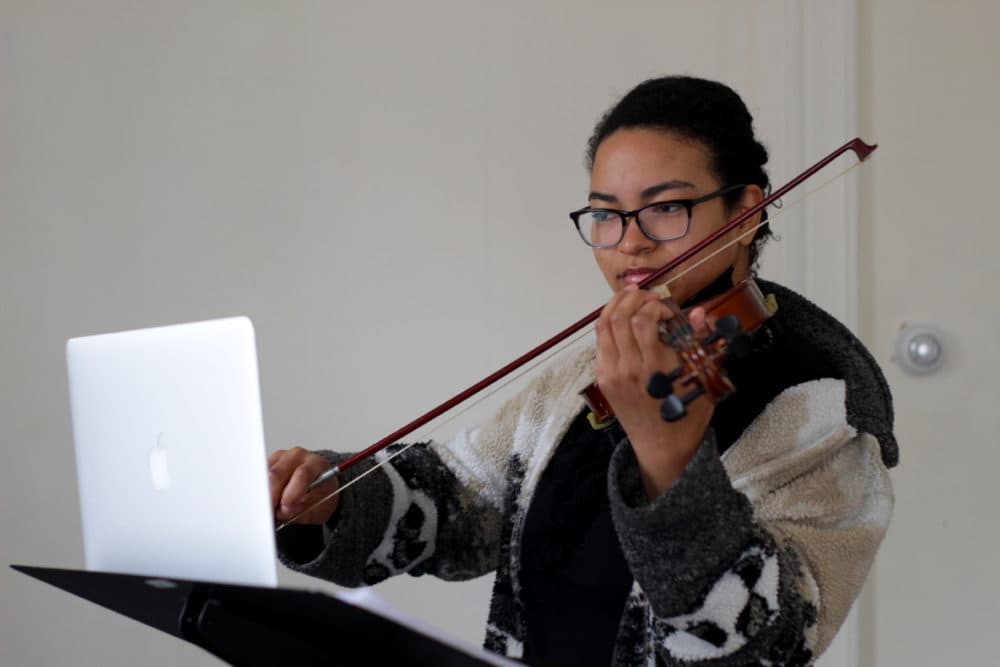Advertisement
In Quarantine, The Beat Goes On For Music Teachers

Music makes the people come together, but what happens when coming together isn’t a possibility? Throughout the lockdown, the music teachers of the Hub have been diligently continuing their practice. Making use of Zoom, Google Hangouts, YouTube and good old-fashioned elbow grease, the pulse of music education is continuing even as life has seemingly stopped amidst the COVID-19 crisis.
Anaís Azul (who uses the pronouns they/them) is a Boston University graduate and former BU Arts Lab fellow, where they engaged in collaborative music instruction and improvisation for patients at Boston Medical Center. Currently based in Berkeley, California, they are teaching various instruments and voice for two schools: Whole Tone Music Academy in Somerville, Massachusetts and Escuela Bilingüe Internacional in Emeryville, California. Azul notes the challenges of teaching instruments, in their case to young learners.
“I’m usually very hands-on, with consent. Teaching 5 to-8-year-olds, they don’t really have the fine motor skills to press down on the ukulele strings. Sometimes they didn’t have the strength, so I would have to physically press down for them. Which, as you can imagine, is something that isn’t happening online.”
The brunt of online teaching may sometimes fall on the students more than the teachers. For some students, especially young learners, their home environments may be anxiety-provoking or otherwise more distracting than the environment of a music studio. Coupled with Wi-Fi trouble and the occasional unreliability of digital conference platforms, online lessons come with their own fair share of goofs.
“Oh, I’ve had so many technical difficulties! So many,” Azul remarks. “Google Hangouts has a lot of problems. There’s always the problem of delay, and little kids that don’t really know how to mute themselves and unmute themselves yet. ‘Oh, I can see you, can you not see me? I can hear you, but I can’t see you!’ And sometimes there’s even difficulties getting on the call."
As a result, some schools and teachers are switching to a video-based lesson model. Azul maintains some of these lessons on their YouTube channel. Boston-born recording artist Ava Sophia also employs this as part of her teaching practice at the Boston Chinatown Neighborhood Center.
“We’ve been sending pre-recorded lessons to parents, with no obligations for students to actually complete the lessons,” says Ava Sophia. “Pre-recorded lessons are not ideal. We’re the only after-school program in Chinatown that didn’t put their part-time employees on furlough, so I just feel really appreciative of having some way to work from home during this time.”
For others, like Dorchester-based Hannah Schzde, the reduced pressure to commute for teaching lessons has made the flow of work even more intuitive.
“I have 90 students in total, so it’s been crazy trying to reach all of them. It was even difficult at times before the lockdown to have to go to their house to teach them. But they were the first to reach out to me, asking if I was doing online classes. It’s been surprisingly fun!"
Still, this time hasn’t been so universally easy. Most of the music teachers interviewed experienced a dip in patronage from the beginning of the crisis to now, although two said it was starting to rebound. At least one music teacher contacted for this article had received a donation from someone else’s stimulus check to cope with lost income. One teacher interviewed was displaced due to the crisis, owing to living in graduate student housing that had to shutter due to pandemic response provisions. However, none of the music teachers interviewed had applied to any relief funds, for example the Boston Music Maker COVID-19 Relief Fund.
That said, the stimulation provided by music education may be just what folks need during this time — young learners included.
Aditya Rohit works full-time at HubSpot in Cambridge, and teaches Indian classical music to 10 students on the side in partnership with LearnQuest Academy in Waltham. He notes the adeptness of his students even during this time.
“I’m lucky that all 10 of them are very committed — they all want to learn. They practice. And if class isn’t there, then they’re upset, ‘cause they practiced, and they wanted to present what they practiced!”
For Steve Chandy, who teaches ages 3.5 and up for InHome Jams/The Jamzone, it was necessary to get creative — and get back to basics.
“Figuring it out was really difficult. Some students don’t have instruments at home. I told their parents to get pots and pans and wooden spatulas,” he says with a chuckle. Chandy went from teaching over 100 students in February to around 70 now. Still, he remains optimistic. “Kids are resilient, so they have the ability to take it step-by-step. And my company trusted their teachers to take a chance on virtual lessons from the get-go. For them to do that, I think we’re all better for it."
Azul maintains that this experience is a challenge throughout, but one that music teachers can overcome with the right attitude.
“I used to just walk into the lesson, spend a half hour there, and then leave. Now, I’m definitely putting more effort into this than I used to, and I think that’s making me a better teacher."
Hassan Ghanny is a writer and performer based in Jamaica Plain. He is a regular contributor to Boston Hassle. He can be found on Twitter @hassan_ghanny and on Instagram @diaspora.gothic.
